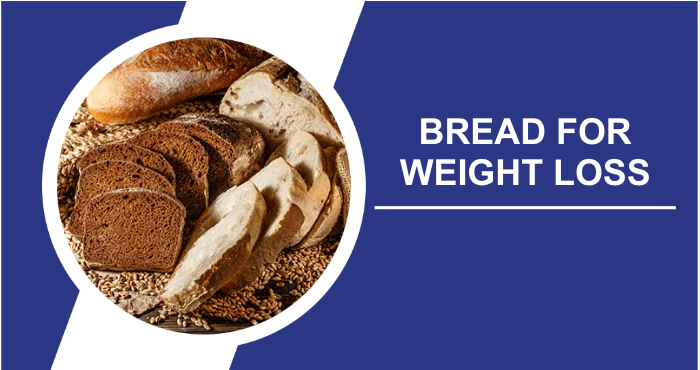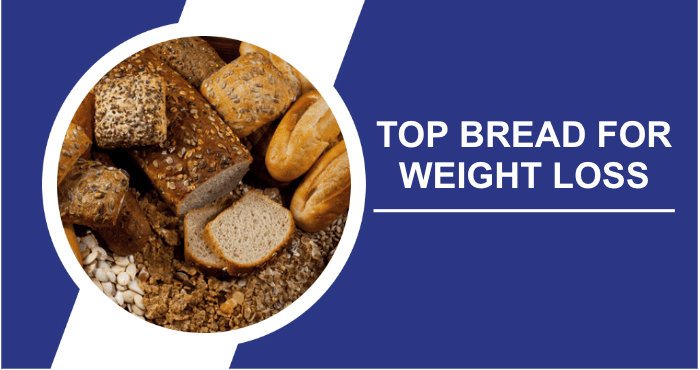In a world where carbohydrates have been vilified as harmful to our weight, it may come as a surprise to learn that bread can be beneficial in a well-rounded weight management plan. Bread can contribute to prolonged satiety and effective hunger control. A healthy balance of carbohydrates and fiber is essential to a balanced diet, so choosing the right type of bread to meet your weight loss goals is crucial.
So, is there an optimal bread choice for losing pounds? There are healthier bread options than others, and while the occasional white bread indulgence is permissible, it is advisable to shift your focus to more nutritious alternatives, such as buckwheat. Whole-grain breads and whole-wheat flour varieties are excellent substitutes, boasting higher fiber content and typically fewer calories than their refined counterparts.
Top Bread Choices For Weight Loss Some of the most nutritionally beneficial gluten-containing bread options for weight loss include:
In terms of gluten-free bread choices, some of the most beneficial choices include:
In addition, in many supermarkets, you can easily find:
What Foods Should I Avoid When Dieting?
If you’re on a diet, it’s important to stay away from sugary temptations like ice cream and candy, as well as high-calorie, low-nutrient foods like fast-food burgers and fries. You should also avoid overeating processed snacks and sugary drinks. Instead, focus on nourishing your body with whole foods like fruits, vegetables, lean proteins, and whole grains to achieve your health and fitness goals.
When Did People Start Baking Bread?
The art of baking bread has a rich history dating back thousands of years. Humans began baking bread about 14,000 years ago when they discovered how to grind grains into flour and mix it with water to make dough. Early bread-making methods were simple, such as drying the dough in the sun or baking it on hot rocks or in the ashes of a fire.
As civilizations developed, so did bread-making techniques. In ancient Egypt, around 3000 B.C., they used yeast to leaven their bread, resulting in the fluffy loaves we know today. Since then, bread has been a staple of the human diet, evolving into the diverse world of bread we enjoy today, from baguettes to sourdough. Its enduring appeal speaks to its fundamental place in human culinary history.
The Best Bread For Weight Loss

Which bread is best for weight loss? Choosing the right bread is crucial. As mentioned above, consumption of refined white bread has been associated with weight gain, while whole grain breads are more likely to be associated with maintaining a healthy weight range. Therefore, the primary guideline when looking for bread is to avoid products made with refined white flour.
Currently, there is a wide variety of bread options that include both gluten-containing and gluten-free varieties. Certain alternative flours used in bread production have distinct nutritional profiles that could complement a well-rounded weight management strategy in conjunction with other dietary measures, such as the integration of fat-burning supplements.
Gluten-Containing Breads
When it comes to gluten-containing bread options that are beneficial for weight loss, consider sourdough bread, Ezekiel bread, and rye bread. Rye bread is known to have a lower glycemic index than white bread, making it a favorable choice for regulating blood sugar levels.
Research suggests that rye-based foods may have a positive effect on insulin metabolism and may help prevent diabetes. In addition, rye is associated with reduced inflammatory markers compared to its refined counterpart and may have a cholesterol-lowering effect.
Ezekiel bread is made from sprouted grains and legumes, making it rich in protein and dense in nutrients. The sprouting process releases vitamins, minerals, and proteins that would otherwise be trapped in the grain’s cell walls, making them more bioavailable to the body. Sprouted grains also contain increased levels of antioxidants and beneficial enzymes that aid digestion and enhance the absorption of nutrients from other sources.
Sourdough bread is made with a natural yeast starter, resulting in a lower glycemic index than other types of bread, reducing the likelihood of blood sugar spikes. Sourdough bread may be beneficial for weight loss because it contains microbes that can potentially improve the health of the gut microbiome, which has been linked to improved weight management.
Gluten-Free Breads
When considering gluten-free bread choices, some of the healthiest options to explore are buckwheat bread, millet bread, and quinoa bread.
Millet bread stands out as a low-calorie, lectin-free option that is rich in antioxidants and essential minerals such as iron and phosphorus. It also contains bioactive compounds that have the potential to moderate blood sugar spikes, lower cholesterol, reduce high blood pressure, and promote a balanced gut microbiome.
Buckwheat bread is known for its high protein and fiber content, as well as its rich supply of essential nutrients, including magnesium and potassium. This type of bread also contains rutin, a compound associated with reduced risk of heart disease, decreased body weight and fat mass, and improved glucose metabolism.
Quinoa bread emerges as another gluten-free alternative known for its high protein and fiber content, along with the presence of essential amino acids critical for muscle repair and growth. It serves as an excellent choice for those seeking easily digestible complex carbohydrates and a bread with increased protein content to help regulate blood sugar levels.
Low-Calorie Bread Choices
Many supermarkets offer breads designed specifically for weight management. You can find specially formulated gluten-containing and gluten-free bread options with reduced calorie counts per slice. If your primary goal is weight loss, these low-calorie breads may be your first choice.
Is Bread Good For Weight Loss?
Yes, bread can be beneficial for weight loss when incorporated into a well-rounded diet plan. If your weight loss journey typically includes consuming white bread, switching to a few slices of whole wheat or whole grain bread instead of refined white bread can reduce your daily intake of processed carbohydrates, which research suggests may aid in weight loss.
Benefits Of Healthy Bread For Weight Loss
Several studies have suggested a possible link between white bread consumption and an increased risk of obesity, while whole grain breads, such as whole wheat bread, have been associated with lower levels of abdominal fat. This reduction in abdominal fat may be due to the fiber content and lower glycemic index of whole grain bread.
Diets that are both high in fiber and restricted in calories have been shown to be positively associated with weight loss. Whole grains, including whole wheat and multigrain breads, are important sources of fiber. Incorporating one or two servings of whole grain bread into your daily diet can help curb cravings for unhealthy foods. The fiber in bread helps you feel fuller longer, which reduces the likelihood of snacking between meals.
This can lead to an overall reduction in caloric intake, which can help you lose belly fat. Bread also serves as a valuable source of complex carbohydrates, providing sustained energy throughout the day. This sustained energy can help you maintain your performance during exercise, potentially leading to increased calorie burning. It is recommended that complex carbohydrates provide up to half of our daily caloric intake.
Most types of bread are rich in complex carbohydrates and contain essential vitamins and minerals to help meet your daily nutritional needs. Whole grains provide vitamins such as B6, niacin, thiamin, riboflavin, and folate, as well as minerals such as zinc, calcium, magnesium, and iron. Maintaining adequate levels of these essential nutrients can support weight loss by ensuring that your body functions optimally.
Are There Delicious Alternatives To Bread?
Absolutely! For those seeking variety or managing dietary restrictions, there’s a world of delicious alternatives to traditional bread. Crispy lettuce wraps are a refreshing choice, providing a crunchy container for your favorite fillings. Sweet potato toast offers a unique twist, as thinly sliced sweet potatoes can be toasted and topped with various toppings such as avocado or almond butter.
Cauliflower crust pizza is a low-carb favorite, while zucchini noodles (“zoodles”) offer a gluten-free alternative to pasta. For those with a sweet tooth, banana bread made with almond or coconut flour can be a delicious treat. Exploring these alternatives can add excitement and flavor to your meals while accommodating a variety of dietary needs.
How to Make the Healthiest Bread Choices For Weight Loss
The first step in choosing the healthiest bread is to identify the bread that meets your nutritional needs. If your goal is weight loss, you may choose bread made from low-calorie flours such as rice, corn, or tapioca. Conversely, if your goal is to increase your fiber intake, you may want to choose a high-fiber bread, even if it is slightly higher in calories.
For individuals seeking digestive support or addressing gut issues, sprouted bread may be a viable and health-conscious option. However, it is important to follow certain guidelines when looking for a healthy loaf of bread:
- Check the label or ask the bakery staff to confirm that the bread you choose is 100% whole or sprouted grain.
- Check the nutrition label to make sure the bread is high in fiber and protein.
- Check the ingredients list to make sure there are no added sugars, oils, or butter, as these additives can significantly increase the calorie and fat content of your bread.
What Happens If I Eat Too Much Bread?
Eating too much bread can have a number of consequences. Excessive consumption of bread, especially refined white bread, can contribute to weight gain due to its high carbohydrate and calorie content. It can also lead to spikes in blood sugar levels, which over time can increase the risk of insulin resistance and type 2 diabetes.
In addition, overeating bread can cause digestive discomfort such as bloating and gas, especially for people who are sensitive to gluten. To maintain a balanced diet and avoid these problems, it’s wise to enjoy bread in moderation while incorporating a variety of other nutritious foods into your meals.
Frequently Asked Questions
Can I still enjoy bread while attempting to shed pounds?
Absolutely! Bread can be a part of your weight loss journey if you make informed choices and effectively manage your portions. The selection of the right kind of bread is pivotal.
Are there any types of bread to steer clear of during weight loss efforts?
Indeed, it’s advisable to steer clear of white bread made from refined flour. These bread varieties have a high glycemic index, which can contribute to weight gain if consumed excessively.
What’s the optimal bread choice for those aiming to lose weight?
Often, the best bread for weight loss is whole-grain or whole wheat bread. These types are rich in dietary fiber, promoting a feeling of fullness and aiding in weight management by curbing overindulgence.
How much bread should I incorporate while striving for weight loss?
The key is moderation. Typically, consuming one to two servings of bread per day should harmonize well with most weight loss plans, with portion control being a crucial factor.
Are homemade bread recipes more conducive to weight loss goals?
Crafting homemade bread provides better control over the ingredients, facilitating the creation of a healthier, lower-calorie option that aligns with your weight loss objectives.
Conclusion
Including bread in your daily weight loss plan can be a smart choice, but the key lies in choosing the right kind of bread. Fortunately, there are a plethora of healthy bread options readily available in grocery stores, and you can also embark on the satisfying journey of making your own bread at home.
The effort is worth it, as a holistic and health-conscious approach to eating is paramount to a balanced diet. By making informed bread choices that align with your nutritional goals, you can enjoy the benefits of both weight management and overall wellness. Enjoy!
Sources
- Lau, S.W., Chong, A.Q., Chin, N.L., Talib, R.A. and Basha, R.K. (2021). “Sourdough Microbiome Comparison and Benefits.” Microorganisms, 9(7), p.1355. Read article
- Benincasa, P., Falcinelli, B., Lutts, S., Stagnari, F. and Galieni, A. (2019). “Sprouted Grains: A Comprehensive Review.” Nutrients, 11(2), p.421. Read article
- Jonsson, K., Andersson, R., Bach Knudsen, K.E., Hallmans, G., Hanhineva, K., Katina, K., Kolehmainen, M., Kyrø, C., Langton, M., Nordlund, E., Lærke, H.N., Olsen, A., Poutanen, K., Tjønneland, A. and Landberg, R. (2018). “Rye and health – Where do we stand and where do we go?” Trends in Food Science & Technology, 79, pp.78–87. Read article
- Yang, J., Lee, J. and Kim, Y. (2020). “Effect of Deglycosylated Rutin by Acid Hydrolysis on Obesity and Hyperlipidemia in High-Fat Diet-Induced Obese Mice.” Nutrients, 12(5), p.1539. Read article
- Sabuz, A.A., Rana, M.R., Ahmed, T., Molla, M.M., Islam, N., Khan, H.H., Chowdhury, G.F., Zhao, Q. and Shen, Q. (2023). “Health-Promoting Potential of Millet: A Review.” Separations, 10(2), p.80. Read article
- El-Sohaimy, S.A., Shehata, M.G., Mehany, T. and Zeitoun, M.A. (2019). “Nutritional, Physicochemical, and Sensorial Evaluation of Flat Bread Supplemented with Quinoa Flour.” International Journal of Food Science, 2019, pp.1–15. Read article
- Wu, W.-C., Inui, A. and Chen, C.-Y. (2020). “Weight loss induced by whole grain-rich diet is through a gut microbiota-independent mechanism.” World Journal of Diabetes, 11(2), pp.26–32. Read article
- de la Fuente-Arrillaga, C., Martinez-Gonzalez, M.A., Zazpe, I., Vazquez-Ruiz, Z., Benito-Corchon, S. and Bes-Rastrollo, M. (2014). “Glycemic load, glycemic index, bread and incidence of overweight/obesity in a Mediterranean cohort: the SUN project.” BMC Public Health, 14(1). Read article
- Serra-Majem, L. and Bautista-Castaño, I. (2015). “Relationship between bread and obesity.” British Journal of Nutrition, 113(S2), pp.S29–S35. Read article
- Miketinas, D.C., Bray, G.A., Beyl, R.A., Ryan, D.H., Sacks, F.M. and Champagne, C.M. (2019). “Fiber Intake Predicts Weight Loss and Dietary Adherence in Adults Consuming Calorie-Restricted Diets: The POUNDS Lost (Preventing Overweight Using Novel Dietary Strategies) Study.” The Journal of Nutrition, 149(10), pp.1742–1748. Read article
Jayson Peterson is an experienced pharmacist, naturopathic physician, medical examiner, and minister. After earning his Doctor of Pharmacy degree from the Medical University of South Carolina, Jayson Peterson completed clinical rotations at several prestigious healthcare institutions and has been affiliated with several pharmacy chains throughout his career. His main passion and zeal is focused on providing world-class patient care by giving precise details and thorough instructions to those who need it most.

